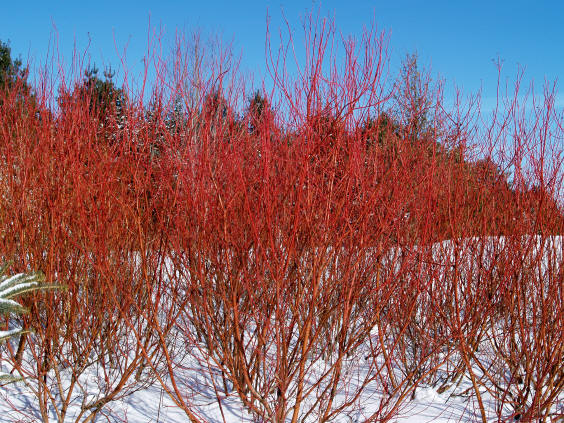Carolyn Black
Adams County Master Gardener
 (3/9) For many gardeners, one of the disadvantages of winter is the lack of color in a garden. However, there are techniques that will assure vibrant hues and interest to your landscape year-round. Foliage color is important in a landscape. Conifers offer excellent color throughout
the year. A variety of dwarf, intermediate and large conifers provide dimension to a landscape and also provide shelter for wildlife in the winter. There are varieties of arborvitae that are bright gold throughout all seasons. They provide contrast to greens in the landscape. Blue spruce adds a lovely hue to any garden. Mountain laurel and rhododendron are beautiful
accents in the winter and provide a showcase of beautiful blooms in the Spring.
(3/9) For many gardeners, one of the disadvantages of winter is the lack of color in a garden. However, there are techniques that will assure vibrant hues and interest to your landscape year-round. Foliage color is important in a landscape. Conifers offer excellent color throughout
the year. A variety of dwarf, intermediate and large conifers provide dimension to a landscape and also provide shelter for wildlife in the winter. There are varieties of arborvitae that are bright gold throughout all seasons. They provide contrast to greens in the landscape. Blue spruce adds a lovely hue to any garden. Mountain laurel and rhododendron are beautiful
accents in the winter and provide a showcase of beautiful blooms in the Spring.
Red twig dogwoods will compliment any landscape. Its red stems up the ante of a picturesque white winter. In fact, their color gets deeper as the winter progresses. Red twig dogwood shrubs can grow to a height of eight feet. They should be planted somewhere in your yard where they can be easily viewed from a window, to take advantage of their
status as top-notch specialty plantings for winter landscapes.
Winterberry holly is a favorite because of its bright red berries. The female produces the beautiful berries and a compatible male is needed to pollinate the female. Winterberry prefers acidic soils. It can be grown in partial shade or full sun but locating your bush in an area with more sunlight will increase berry production. Unlike the holly
shrubs with which we are most familiar, winterberry holly is deciduous. At first, one might think of this factor as a drawback, but it is actually a benefit because winterberry holly's exciting display of red berries is enhanced as this holly shrub sheds its leaves. All the attention is drawn to the plant's fruit, with no foliage to obstruct the viewer's vision.

Don’t forget about planting bulbs in your gardens. Snowdrops are one of the earliest bulbs to bloom. They are a small genus of about 20 species of bulbous perennial herbaceous plants in the family Amaryllidaceae. The plants are petite and have two linear leaves and a single small white drooping bell-shaped flower with six petal-like tepals. The
smaller inner petals have green markings. You will see them appear in February if there is no snow covering them. The bulbs will need planted in October to enjoy in late winter. A heavy and fertile soil with plenty of organic matter is best and an area with dappled shade is a perfect location for snowdrops.
A favorite for any garden is Hellebore, whose common name is Lenten Rose. It is an ideal plant for a shady spot in a landscape. This long-blooming low-maintenance herbaceous perennial can flower before the snow melts. The blooms are often fragrant and last from March to May in Pennsylvania. Gardeners fall in love with Hellebores when they see the
flowers with their dainty heads nodding in the breeze in a spectrum of hues. This is when hellebores take center stage. Their range of colors from pure white, yellow, green, pink, plum, or dark midnight purple is a wonderful display in the landscape. Most of the common hellebores are clump-forming, low-growing evergreens with toothed, palmate foliage.
Witch hazel is a shrub that blooms as winter nears the end. The native witch hazel has flowers that are reddish to yellow and have both male and female parts on one flower. The flower clusters begin to expand in the autumn before the leaves fall, and continue throughout the winter. The black nuts that come next, still encased in their seedpods,
wait to ripen several months later. Witch hazels are deciduous shrubs that grow ten to twenty-five feet. Witch hazel is a favorite of birds. It will grow in sun or part shade and prefers moist, acidic soil. It is resistant to most diseases.
Consider adding some of these bulbs, perennials, shrubs, and trees to your landscape for four-season beauty. With the proper plantings to complement each other and appropriate maintenance and care, there is no reason why you can’t look out your window and enjoy your landscape all year.
Read other articles on garden and landscape design
Read other articles by Carolyn Black